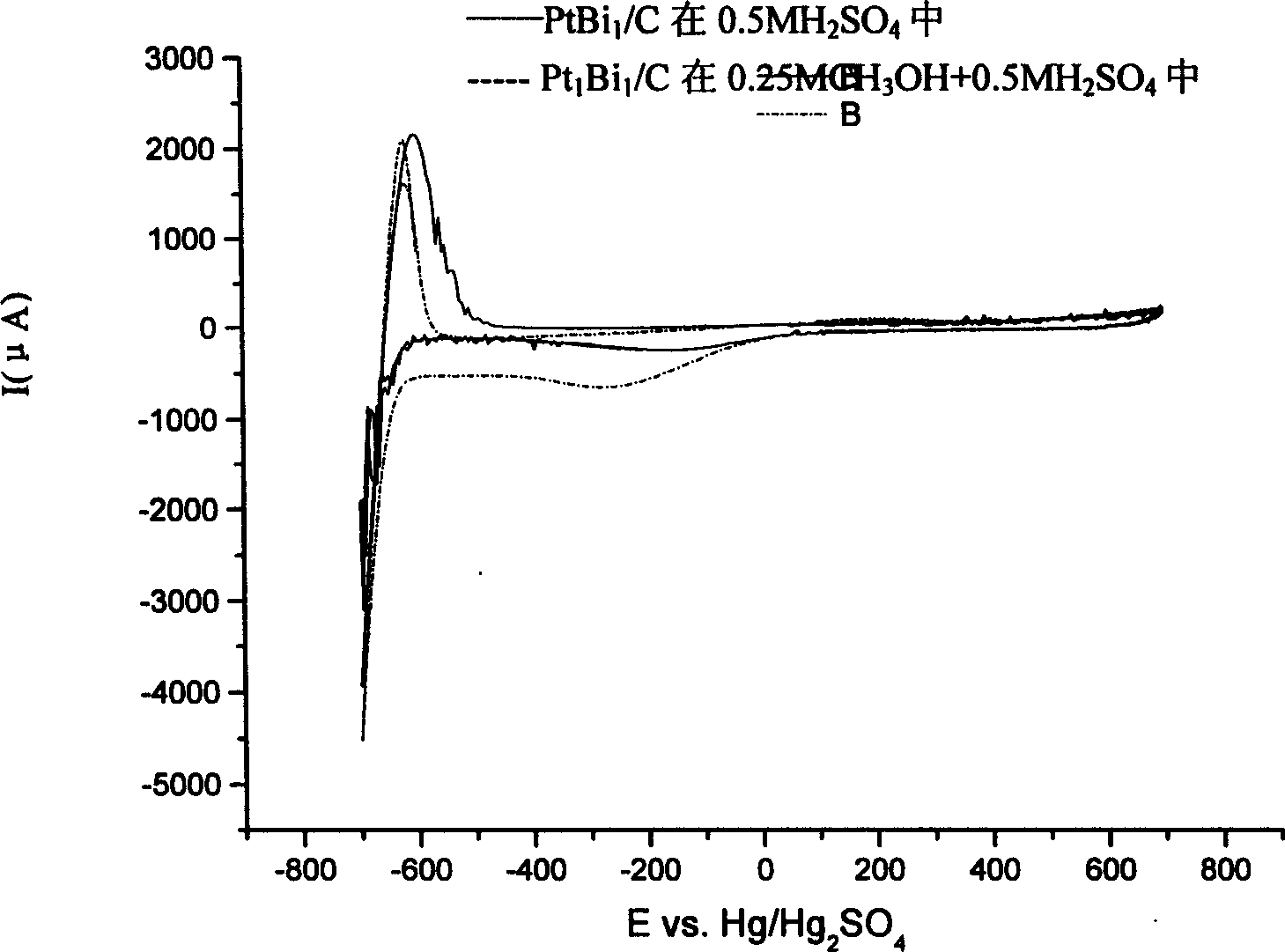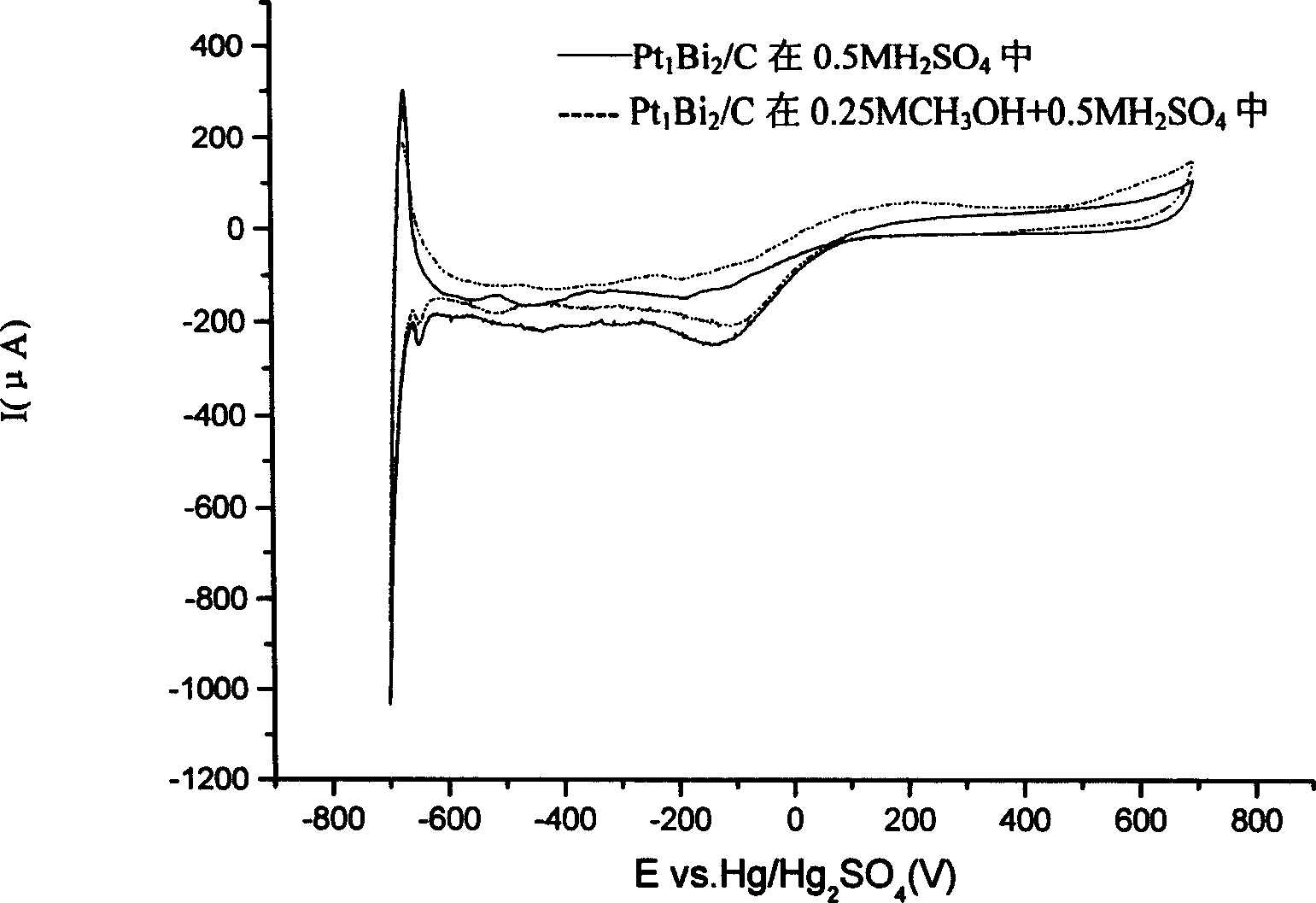Method for preparing methanol poisoning resistant cathode catalyst of fuel cell
A cathode catalyst, fuel cell technology, applied in battery electrodes, chemical instruments and methods, physical/chemical process catalysts, etc.
- Summary
- Abstract
- Description
- Claims
- Application Information
AI Technical Summary
Problems solved by technology
Method used
Image
Examples
experiment approach 1
[0026] Dissolve chloroplatinic acid and bismuth chloride in 2mol / L hydrochloric acid at a molar ratio of 1:1, and add polyvinylpyrrolidone (PVP) as a protective agent, wherein the sum of polyvinylpyrrolidone, chloroplatinic acid and bismuth chloride The molar ratio is 15:1, and sodium borohydride is added under stirring conditions, wherein the molar ratio of sodium borohydride, chloroplatinic acid and bismuth chloride is 20:1, and nano-platinum-bismuth alloy and nano-platinum-bismuth metal are prepared compound sol. Add a certain amount of pretreated carbon powder into the sol and stir for several hours. The mass ratio of carbon powder to the sum of chloroplatinic acid and bismuth chloride is 4:1. After drying the sample under low pressure, use distilled water and acetone repeatedly washing and vacuum drying to obtain the carbon-supported nano-platinum-bismuth alloy and nano-platinum-bismuth intermetallic compound catalyst of the present invention.
experiment approach 2
[0028] Dissolve chloroplatinic acid and bismuth chloride in 2mol / L hydrochloric acid at a molar ratio of 1:2, and add polyvinylpyrrolidone (PVP) as a protective agent, wherein the sum of polyvinylpyrrolidone, chloroplatinic acid and bismuth chloride The molar ratio is 15:1, and sodium borohydride is added under stirring conditions, wherein the molar ratio of sodium borohydride, chloroplatinic acid and bismuth chloride is 20:1, and nano-platinum-bismuth alloy and nano-platinum-bismuth metal are prepared compound sol. Add a certain amount of pretreated carbon powder into the sol and stir for several hours. The mass ratio of carbon powder to the sum of chloroplatinic acid and bismuth chloride is 4:1. After drying the sample under low pressure, use distilled water and acetone repeatedly washing and vacuum drying to obtain the carbon-supported nano-platinum-bismuth alloy and nano-platinum-bismuth intermetallic compound catalyst of the present invention.
experiment approach 3
[0030]Dissolve chloroplatinic acid and bismuth chloride in 2mol / L hydrochloric acid at a molar ratio of 1:5, and add polyvinylpyrrolidone (PVP) as a protective agent, wherein the sum of polyvinylpyrrolidone, chloroplatinic acid and bismuth chloride The molar ratio is 15:1, and sodium borohydride is added under stirring conditions, wherein the molar ratio of sodium borohydride, chloroplatinic acid and bismuth chloride is 20:1, and nano-platinum-bismuth alloy and nano-platinum-bismuth metal are prepared compound sol. Add a certain amount of pretreated carbon powder into the sol and stir for several hours. The mass ratio of carbon powder to the sum of chloroplatinic acid and bismuth chloride is 4:1. After drying the sample under low pressure, use distilled water and acetone repeatedly washing and vacuum drying to obtain the carbon-supported nano-platinum-bismuth alloy and nano-platinum-bismuth intermetallic compound catalyst of the present invention.
[0031] Preparation method ...
PUM
| Property | Measurement | Unit |
|---|---|---|
| particle diameter | aaaaa | aaaaa |
Abstract
Description
Claims
Application Information
 Login to View More
Login to View More - R&D
- Intellectual Property
- Life Sciences
- Materials
- Tech Scout
- Unparalleled Data Quality
- Higher Quality Content
- 60% Fewer Hallucinations
Browse by: Latest US Patents, China's latest patents, Technical Efficacy Thesaurus, Application Domain, Technology Topic, Popular Technical Reports.
© 2025 PatSnap. All rights reserved.Legal|Privacy policy|Modern Slavery Act Transparency Statement|Sitemap|About US| Contact US: help@patsnap.com



